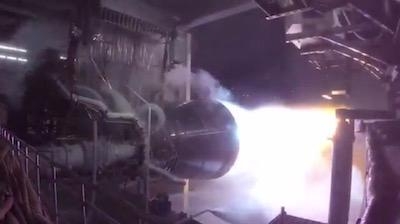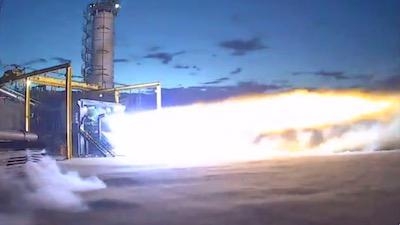Tue, Oct 24, 2017
Will Power The New Glenn Rocket, As Well As ULA Spacecraft
Blue Origin has successfully test-fired its BE-4 rocket engine at its facility in west Texas.

Geekwire reports that the engine, which is fueled by liquefied natural gas, was shipped from the manufacturing facility in Kent, WA to the test range in Texas. Jeff Bezos Tweeted on October 19 that the engine test-fire was a success.
The engine will power Blue Origin's orbital-class New Glenn rocket, which will be built at the company's factory in Florida near the Kennedy Space Center. That facility is expected to be completed by the end of the year. The New Glenn is scheduled for its first flight by 2020, and Blue Origin has already inked deals with several commercial customers for satellite launches that year. Bezos has said that he plans to bid for national security contracts, and hopes to be able to convince NASA to use the BE-4 to send spacecraft to the moon.
The company also has a contract with United Launch Alliance to supply engines for its new Vulcan rocket. That booster is expected to fly for the first time in 2019. It is designed to replace the Russian-made RD-180 engine that is currently used by some companies launching U.S. payloads into space.
The hot fire on October 19 did not reach full power, but was deemed successful nonetheless.

According to Blue Origin's website, BE-4 is the only engine that can fly by 2019, meeting the congressionally mandated deadline to eliminate dependence on Russian-built engines. The alternative engine option is multiple years behind and could not be integrated into a launch vehicle until at least 2021, extending our dependence on Russian engines well beyond 2019.
BE-4 is the only engine that can fly by 2019, meeting the congressionally mandated deadline to eliminate dependence on Russian-built engines. The alternative engine option is multiple years behind and could not be integrated into a launch vehicle until at least 2021, extending our dependence on Russian engines well beyond 2019.
(Images from video Tweeted by Jeff Bezos)
More News
Aero Linx: Model Aeronautical Association of Australia MAAA clubs are about fun flying, camaraderie and community. For over 75 years, the MAAA has been Australia’s largest fl>[...]
Touchdown Zone Lighting Two rows of transverse light bars located symmetrically about the runway centerline normally at 100 foot intervals. The basic system extends 3,000 feet alon>[...]
“Discovery and innovation are central to our mission at Virgin Galactic. We’re excited to build on our successful record of facilitating scientific experiments in subor>[...]
How To Get A Story On Aero-TV News/Feature Programming How do I submit a story idea or lead to Aero-TV? If you would like to submit a story idea or lead, please contact Jim Campbel>[...]
Student Pilot Reported That During Rotation, “All Of A Sudden The Back Of The Plane Kicked To The Right..." Analysis: The student pilot reported that during rotation, “>[...]
 ANN's Daily Aero-Linx (05.02.24)
ANN's Daily Aero-Linx (05.02.24) ANN's Daily Aero-Term (05.02.24): Touchdown Zone Lighting
ANN's Daily Aero-Term (05.02.24): Touchdown Zone Lighting Aero-News: Quote of the Day (05.02.24)
Aero-News: Quote of the Day (05.02.24) ANN FAQ: Contributing To Aero-TV
ANN FAQ: Contributing To Aero-TV NTSB Final Report: Cirrus Design Corp SR20
NTSB Final Report: Cirrus Design Corp SR20




